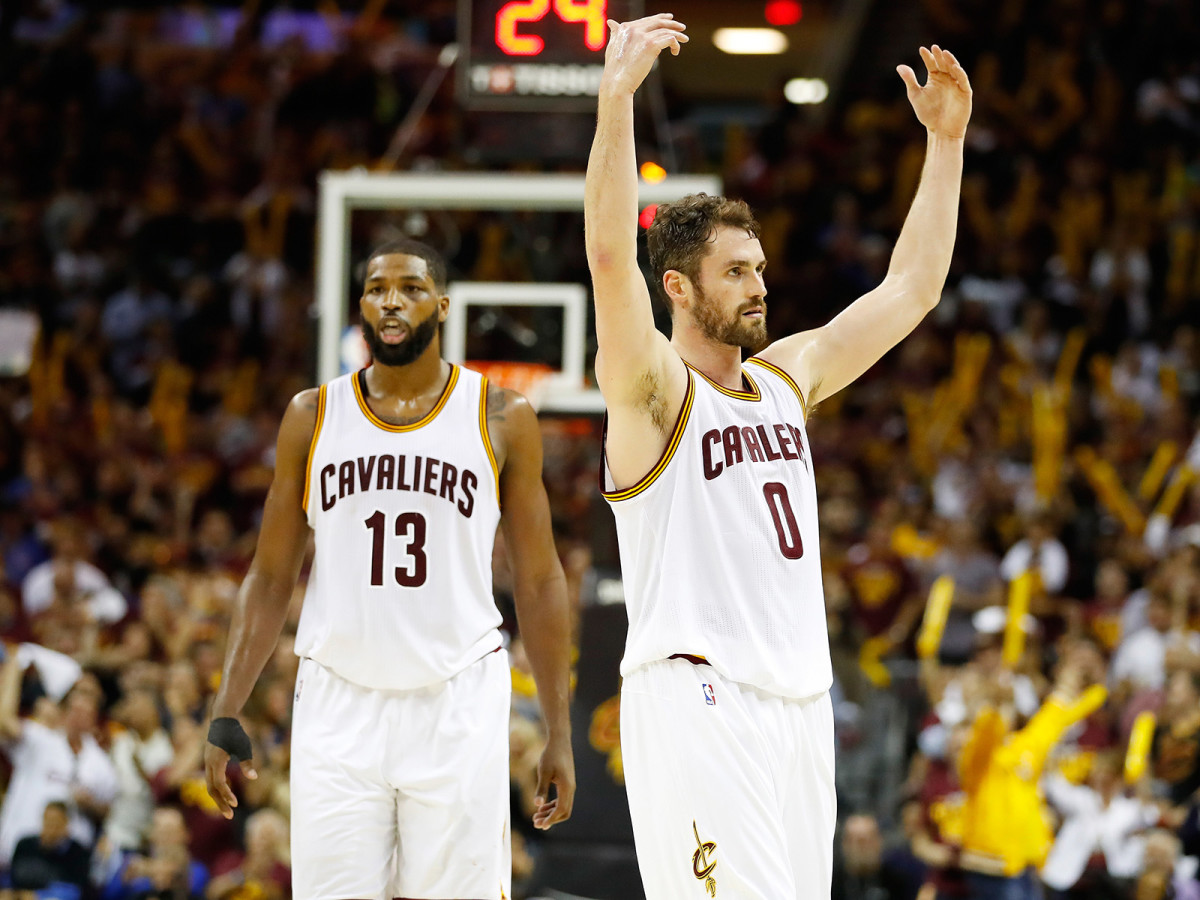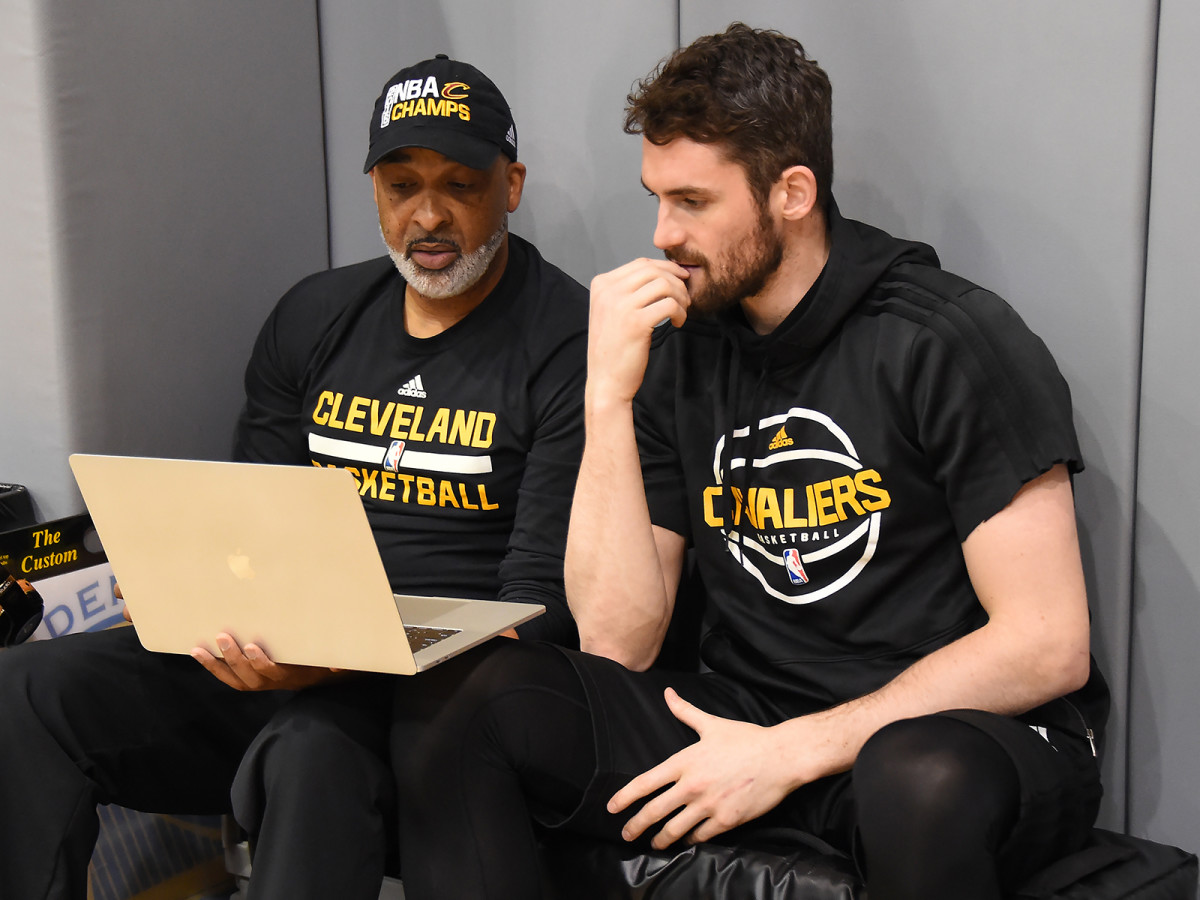Kevin Love Positioned to Serve as Cavs' Connective Tissue

It’s a brave new world for the Cleveland Cavaliers, who were forced well out of their comfort zone by spiraling circumstance. The three-time Eastern Conference champions are no more; Kyrie Irving saw to that when he demanded a trade, one that would fundamentally change the makeup of a contender.
Then came the aftershocks. The deal Cleveland built all but forced Derrick Rose, whom the Cavs signed back in July for the veteran minimum, into the starting lineup while Isaiah Thomas recovers from injury. The acquisition of Jae Crowder gently nudged the Cavs toward small ball. In tandem, those two developments cleared the way for Kevin Love to start at center while Tristan Thompson moves to the bench. With different personnel comes different rotational needs.
Will LeBron's Cavs Cruise Above the Central's Fray?
Thompson, unsurprisingly, has accepted the change about as graciously as one could. “It was fine," Thompson said, per ESPN.com. "I definitely knew where [Cavs coach Tyronn Lue] was coming from and it was definitely tough, I could see when I was talking to him, but I told him I'm one guy you don't have to worry about.”
This is what makes Thompson special. No matter when he plays or which teammates he plays with, Thompson works his way through defensive possessions and scraps for offensive rebounds with consistent resolve. He is as low-maintenance as NBA players come. Thompson would probably prefer to start, on some level, and clearly deserves to. He just isn’t the sort to make a fuss when decisions are made for the sake of the team.
Players that flexible in approach provide options. So many coaches are bound by the politics of player salaries and expectations to the point that they aren’t able to try new things or even field their best lineups. It is to Thompson’s credit—and the Cavs’ benefit—that he’s willing to play along.

This lineup change is a compensatory measure. Replacing Irving with Rose comes a geometric cost, given that Irving is a brilliant shooter from the perimeter and Rose hit just 21.7% of his three-point attempts last season. Moving Love to center attacks the problem sideways. Rather than ask Rose to be something he’s not, the Cavs will surround him with as much shooting as they can muster. The frontcourt combination of Love, Jae Crowder, and LeBron James leaves nowhere for a traditional center to hide. Any matchup will pull opposing bigs out of the paint and into trouble. This suits Rose, whose downhill style should course smoothly through the lanes that Love will help to create.
Roundtable: Who Was the Biggest NBA Star Traded This Summer?
The more time that Love logs at center, the more strongly his game will be drawn to the perimeter. Nearly a quarter of Love’s possessions last season went to post-ups, according to Synergy Sports. That figure isn’t tenable if most of Love’s defenders are bigger and longer than him—advantages that largely neutralize what he does well on the block. It could make sense to deploy Love more often at the high post, though doing so might tip what is already a precarious creative balance between James and Rose. Cleveland wants LeBron in control but also needs Rose, who isn’t much of an off-ball player, to get his turn. Love will live somewhere between them, his passing and shooting serving as the Cavs’ connective tissue.

Pick-and-pop jumpers will be readily available. Spot-up opportunities will make for an easy default. The reason Love works as a center is because he stretches most defenses beyond their breaking point, compromising their principles at a schematic level. When the defenders on the floor don’t believe they can cover enough ground to help in the paint before recovering all the way out to the arc, they hesitate. Players like Love—stretchy bigs with a high, quick release—call into question the very systems that defenses need to survive. To do so with these particular starters, however, could pull Love’s shot distribution outward in the way of Ryan Anderson or Cavs teammate Channing Frye.
As was the case last season, most opponents won’t be able to keep up with the Cavs. The rising tide of LeBron’s passing channeled through a smart, well-spaced offense will prove too much for all but the most talented teams. Even those opponents could find themselves scrambled beyond solvency by some of the lineups Cleveland will put on the floor. So few teams have a wing who can hang with James, a big who can wander outside with Love, and a guard quick enough to stay in front of Rose—much less the discipline to handle the Cavs’ holistic offense. That said, any move of this kind comes at a cost. Moving Thompson out of the starting lineup leaves it vulnerable.
Should the Cavaliers be More Concerned About Dwyane Wade or Derrick Rose?
Structurally speaking, this won’t be a radical departure. It’s not as if Thompson were a traditional rim protector whose verticality would leave a physical void. Both Thompson and Love do their defensive work in space, shuffling along between responsibilities as best they can. The difference between them is purely one of efficacy. Love might be improved as a switch and help defender from his days in Minnesota, but his coverage is a far cry from the sturdy, precise work that Thompson provides.
Don’t underestimate that tradeoff. Cleveland played 371 minutes last season with Love at center between the regular season and playoffs, according to NBA Wowy, and was outscored by more than 10 points per 100 possessions. Regularizing those lineups (Love at center was largely a situational tactic for the Cavs last season, making their performance especially erratic) should help solidify them, though there’s only so much that can be done when Love is the primary help defender behind the likes of Rose, Dwyane Wade, Kyle Korver, and a LeBron pacing himself through the regular season. Another below-average finish in defensive efficiency is to be expected.
Starting Love at center is an option worth trying. It just might turn out to be more a shifting of burden than a clear windfall. Separating Love and Thompson in the lineup demands more of both James and Crowder; it puts a target on Love’s back against the best lineups opponents have to offer; and it could be further complicated if Lue opts to start Wade over J.R. Smith.
Still, you try this because maximizing the space around Rose is of critical importance. You do it because moving Thompson to the bench doesn’t mean you have to decrease his minutes or undercut his importance. Cleveland will retain its basic shape so long as it has LeBron, but their entire season is a rebalancing act. Thompson and Love are simply the easiest pieces to move around the board.
